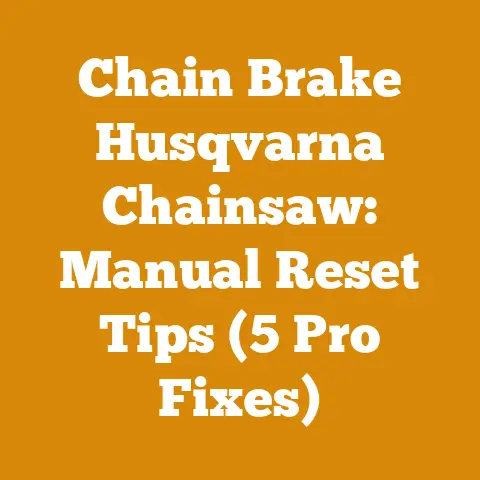Echo 2620 Weed Eater: Ultimate Wood Clearing Tips (5 Pro Hacks)
Understanding the Echo 2620’s Potential for Wood Clearing
The Echo 2620 is primarily designed for lawn care, but with the right attachments and techniques, it can be surprisingly effective for light wood clearing tasks. Think of it as a versatile tool that can handle more than just grass, helping you maintain a clean and manageable landscape.
Why Consider the Echo 2620 for Wood Clearing?
- Versatility: With attachments like brush blades and saw blades, the Echo 2620 can cut through small trees, thick brush, and even help with limbing.
- Cost-Effectiveness: If you already own an Echo 2620, leveraging it for wood clearing can save you money compared to renting or buying specialized equipment.
- Maneuverability: Its lightweight design allows for easy handling in tight spaces and on uneven terrain.
- Ease of Use: Compared to chainsaws, the Echo 2620 is generally easier to operate and maintain, especially for beginners.
5 Pro Hacks for Wood Clearing with the Echo 2620
Here are five professional hacks to maximize your Echo 2620’s wood-clearing capabilities:
Hack 1: The Right Attachment is Key
The standard string trimmer head is useless for wood clearing. You need to upgrade to a specialized attachment. Here are a few options:
- Brush Blades: These multi-toothed blades are excellent for cutting through thick brush, small saplings (up to 2-3 inches in diameter), and dense vegetation. I’ve found that a blade with 8-10 teeth offers a good balance of cutting power and durability.
- Saw Blades: These circular saw blades, often with carbide tips, are designed for cutting through thicker branches and small trees (up to 4-5 inches in diameter). Be extremely cautious when using saw blades, as they are more prone to kickback.
- Metal String Heads: While not ideal for large tasks, metal string heads with heavy-duty lines can handle thicker weeds and light brush more effectively than standard nylon strings.
Hack 2: Mastering the Cutting Technique
Using the right technique can significantly improve your efficiency and safety.
- Sweep and Cut: Instead of trying to force the blade through the wood, use a sweeping motion, allowing the blade to gradually cut through the material.
- Work in Layers: For thicker vegetation, cut in layers, starting from the top and working your way down. This prevents the blade from getting bogged down and reduces the risk of kickback.
- Maintain a Safe Distance: Keep a safe distance from the cutting head and wear appropriate safety gear (eye protection, gloves, and sturdy footwear).
- Anticipate Kickback: Be prepared for kickback, especially when using saw blades. Keep a firm grip on the handle and maintain a stable stance.
Hack 3: Optimizing Engine Performance
A well-maintained engine is crucial for optimal performance.
- Use High-Quality Fuel: Use a high-quality 2-stroke oil mixed with fresh gasoline at the recommended ratio (usually 50:1). I’ve personally found that using premium gasoline can improve engine performance and longevity.
- Clean the Air Filter Regularly: A dirty air filter restricts airflow, reducing engine power. Clean the air filter after each use, or more frequently in dusty conditions.
- Inspect the Spark Plug: A fouled spark plug can cause starting problems and poor performance. Replace the spark plug annually or as needed.
- Adjust the Carburetor: If the engine is running poorly, you may need to adjust the carburetor. Consult the owner’s manual for instructions.
Hack 4: Sharpening and Maintaining Blades
A dull blade is not only inefficient but also dangerous.
- Sharpen Regularly: Sharpen brush blades and saw blades regularly to maintain optimal cutting performance. Use a file or grinder designed for sharpening blades. I typically sharpen my blades after every 2-3 hours of use.
- Inspect for Damage: Check blades for cracks, chips, or other damage. Replace damaged blades immediately.
- Clean After Each Use: Clean blades after each use to remove sap, debris, and other contaminants.
- Store Properly: Store blades in a dry place to prevent rust and corrosion.
Hack 5: Strategic Planning and Safety First
Proper planning and safety precautions are essential for any wood-clearing project.
- Assess the Area: Before you start, assess the area to identify potential hazards, such as rocks, roots, and underground utilities.
- Clear the Area: Remove any loose debris, such as branches and leaves, that could get caught in the blade.
- Wear Safety Gear: Always wear appropriate safety gear, including eye protection, gloves, hearing protection, and sturdy footwear. I also recommend wearing chaps or leg guards for added protection.
- Work in a Safe Environment: Avoid working in wet or windy conditions.
- Take Breaks: Wood clearing can be physically demanding. Take frequent breaks to avoid fatigue.
- Be Aware of Your Surroundings: Pay attention to your surroundings and be aware of other people or animals in the area.
The Real Cost of Wood Clearing: A Deep Dive
While the Echo 2620 can be a cost-effective tool for wood clearing, it’s important to understand the full cost of your project. This includes not only the initial investment in the equipment but also ongoing maintenance, fuel costs, and labor (if you’re hiring help). Let’s break down the different cost components:
1. Equipment Costs:
- Echo 2620 Weed Eater: If you already own one, this cost is sunk. However, if you need to purchase one, expect to pay between $200 and $300 for a new model.
- Brush Blade/Saw Blade Attachments: High-quality brush blades typically cost between $20 and $50, while saw blades can range from $30 to $75, depending on the size and quality. I always opt for carbide-tipped blades, as they offer superior durability and cutting performance.
- Safety Gear: Eye protection, gloves, hearing protection, and sturdy footwear are essential. Expect to spend between $50 and $100 for a complete set of safety gear. Chaps or leg guards can add another $50 to $100 to the cost.
2. Fuel and Maintenance Costs:
- Fuel: The Echo 2620 uses a 2-stroke engine, which requires a mixture of gasoline and oil. A gallon of premium gasoline typically costs around $4, and a quart of 2-stroke oil costs around $10. The fuel consumption rate will vary depending on the type of work you’re doing, but expect to use about 1-2 gallons of fuel per day of heavy use.
- Maintenance: Regular maintenance, such as cleaning the air filter, replacing the spark plug, and lubricating moving parts, is essential for keeping your Echo 2620 in good working condition. The cost of these maintenance items is relatively low, typically around $20-$30 per year. However, if you need to take your Echo 2620 to a repair shop for more extensive repairs, the cost can be significantly higher. I’ve had to replace a carburetor once, which cost me around $80.
- Blade Sharpening/Replacement: As mentioned earlier, sharpening blades regularly is crucial for maintaining optimal cutting performance. If you’re sharpening the blades yourself, the cost is minimal. However, if you’re paying someone to sharpen them for you, expect to pay around $10-$15 per blade. Blades will eventually wear out and need to be replaced.
3. Labor Costs:
- DIY vs. Hiring Help: If you’re doing the work yourself, your labor cost is essentially your time. However, if you’re hiring someone to do the work for you, expect to pay between $20 and $50 per hour, depending on the location, experience, and complexity of the job.
- Estimating Labor Time: Estimating the amount of time required for a wood-clearing project can be challenging. Factors such as the size of the area, the density of the vegetation, and the terrain will all affect the amount of time required. As a general rule of thumb, I estimate that it takes about 1-2 hours to clear 1000 square feet of moderately dense vegetation.
4. Disposal Costs:
- Disposing of Debris: Depending on the size and nature of your wood-clearing project, you may need to dispose of the debris. Options include chipping, burning (where permitted), or hauling it away to a landfill. Chipping is the most environmentally friendly option, but it requires renting or purchasing a wood chipper. Burning is a cost-effective option, but it’s important to check local regulations and obtain any necessary permits. Hauling the debris away to a landfill can be expensive, especially if you have a large amount of material. Landfill fees typically range from $50 to $100 per ton.
5. Permit Costs (If Applicable):
- Local Regulations: Depending on your location, you may need to obtain permits for certain types of wood-clearing activities, such as cutting down trees or burning debris. Permit fees can vary widely, from a few dollars to several hundred dollars, depending on the scope of the project and local regulations. It’s important to check with your local authorities to determine whether any permits are required.
Cost Analysis Example:
Let’s say you need to clear a 5000 square foot area of moderately dense vegetation. Here’s a rough estimate of the costs involved:
- Equipment:
- Brush Blade Attachment: $30
- Safety Gear: $75
- Fuel:
- Gasoline (2 gallons): $8
- 2-Stroke Oil: $2
- Labor (DIY – 10 hours): $0 (Your time)
- Disposal (Chipping – Rental): $100 (Half-day chipper rental)
Total Estimated Cost: $215
This is just a rough estimate, and the actual costs may vary depending on your specific circumstances. However, it gives you a general idea of the types of costs involved in a wood-clearing project.
Real-World Examples and Case Studies
To illustrate the cost factors in action, let’s look at a few real-world examples:
Case Study 1: Small-Scale Firewood Preparation
I have a friend, let’s call him John, who heats his home with wood. He uses an Echo 2620 with a brush blade to clear small trees and branches from his property for firewood. His costs are relatively low because he does most of the work himself and uses wood that’s already on his property. His main expenses are fuel, maintenance, and the occasional replacement blade. He estimates that it costs him around $500 per year to heat his home with wood, which is significantly less than what he would pay for propane or oil.
Case Study 2: Professional Land Clearing
A local landscaping company uses Echo 2620s with saw blades to clear small trees and brush for residential and commercial properties. Their costs are significantly higher than John’s because they have to pay for labor, insurance, and other business expenses. They typically charge between $500 and $1000 to clear a 1/4 acre lot, depending on the density of the vegetation and the terrain.
Case Study 3: Community Firewood Project
In a small rural community, volunteers use Echo 2620s with brush blades to clear brush and small trees from public lands for firewood. The firewood is then distributed to low-income residents. The project is funded by donations and grants, and the volunteers donate their time and equipment. The main expenses are fuel, maintenance, and safety gear. The project provides a valuable service to the community while also helping to reduce the risk of wildfires.
Cost Optimization Tips and Budget Management
Here are some practical tips for optimizing costs and managing your budget for wood processing or firewood preparation projects:
- Plan Ahead: Carefully plan your project before you start. This will help you avoid costly mistakes and ensure that you have the right equipment and supplies.
- Shop Around: Compare prices from different suppliers before you buy anything.
- Buy in Bulk: If you’re buying fuel, oil, or other supplies, consider buying in bulk to save money.
- Maintain Your Equipment: Regular maintenance will help extend the life of your equipment and prevent costly repairs.
- Do It Yourself: If you’re comfortable doing so, consider doing some of the work yourself to save on labor costs.
- Recycle or Reuse: Recycle or reuse as much of the debris as possible to reduce disposal costs.
- Take Advantage of Local Resources: Check with your local government or community organizations to see if there are any grants or programs available to help you with your project.
- Track Your Expenses: Keep track of all your expenses so you can see where your money is going and identify areas where you can save.
Understanding Timber Prices and Fuelwood Market Rates
To effectively budget for wood clearing, it’s helpful to understand the broader timber market and fuelwood rates. Here’s a glimpse:
- Timber Prices: Timber prices vary significantly depending on the species, quality, and location. According to the US Forest Service, the average stumpage price (the price paid for standing timber) for hardwood sawtimber in the Eastern United States was around $200 per thousand board feet in 2023. However, prices can range from $50 per thousand board feet for low-quality timber to over $500 per thousand board feet for high-quality timber.
- Fuelwood Market Rates: Fuelwood prices also vary depending on the location, species, and quantity. According to the Energy Information Administration (EIA), the average price of firewood in the United States was around $250 per cord in 2023. However, prices can range from $150 per cord in rural areas to over $400 per cord in urban areas. In Europe, prices for seasoned firewood can range from €100 to €300 per cubic meter, depending on the region and wood type.
These figures provide a general benchmark, but it’s essential to research local market rates to get a more accurate estimate for your specific project.
Calculating Wood Volume and Drying Time
Understanding how to calculate wood volume and drying time is crucial for firewood preparation. Here are a few key concepts:
- Board Feet: A board foot is a unit of measurement for lumber, equal to 144 cubic inches (12 inches long, 12 inches wide, and 1 inch thick).
- Cords: A cord is a unit of measurement for firewood, equal to a stack of wood 4 feet high, 4 feet wide, and 8 feet long (128 cubic feet).
- Estimating Drying Time: Drying time for firewood depends on several factors, including the species of wood, the size of the pieces, and the climate. As a general rule of thumb, hardwood firewood should be seasoned for at least 6-12 months before burning. Softwood firewood can be seasoned in as little as 3-6 months. Moisture meters are affordable tools that can accurately measure the moisture content of wood. The ideal moisture content for firewood is below 20%.
The formula for estimating the volume of a log in board feet is:
(Diameter in inches)^2 x Length in feet / 16
For example, a log that is 12 inches in diameter and 10 feet long would contain approximately 90 board feet of lumber.
Overcoming Challenges Faced by Small-Scale Loggers and Firewood Suppliers
Small-scale loggers and firewood suppliers often face unique challenges, including:
- Limited Access to Capital: Obtaining financing for equipment and supplies can be difficult.
- Fluctuating Market Prices: Timber and fuelwood prices can be volatile, making it difficult to plan and budget.
- Competition from Larger Operations: Larger logging companies and firewood suppliers often have economies of scale that small-scale operators cannot match.
- Regulatory Compliance: Complying with environmental regulations and safety standards can be costly and time-consuming.
- Access to Markets: Finding reliable buyers for timber and fuelwood can be challenging.
To overcome these challenges, small-scale loggers and firewood suppliers need to:
- Develop a Business Plan: A well-written business plan can help you secure financing and attract customers.
- Network with Other Professionals: Building relationships with other loggers, landowners, and buyers can help you access markets and share information.
- Invest in Efficient Equipment: Efficient equipment can help you reduce costs and increase productivity.
- Focus on Quality: Providing high-quality timber and fuelwood can help you differentiate yourself from the competition.
- Stay Informed: Staying informed about market trends, regulations, and new technologies can help you make informed decisions.
Actionable Takeaways and Next Steps
By now, you should have a much better understanding of how to use your Echo 2620 for wood clearing and how to budget for such projects effectively. Here are some actionable takeaways and next steps:
- Assess Your Needs: Determine the scope of your wood-clearing project and identify the specific tasks you need to accomplish.
- Choose the Right Attachments: Select the appropriate brush blade or saw blade attachment for the type of vegetation you’ll be clearing.
- Invest in Safety Gear: Purchase the necessary safety gear to protect yourself from injury.
- Develop a Budget: Create a detailed budget that includes all of the costs associated with your project.
- Plan Your Work: Plan your work carefully and take frequent breaks to avoid fatigue.
- Start Small: If you’re new to wood clearing, start with a small project and gradually work your way up to larger projects.
- Seek Professional Advice: If you’re unsure about any aspect of your project, seek advice from a qualified professional.
Conclusion: Mastering Wood Clearing with the Echo 2620
The Echo 2620 weed eater, when equipped with the right attachments and used with the proper techniques, can be a valuable tool for wood clearing. By understanding the costs involved and implementing effective cost management strategies, you can successfully complete your wood processing or firewood preparation projects while staying within your budget. Remember, safety should always be your top priority. By following the tips and guidelines outlined in this article, you can transform overgrown areas into usable spaces, clear brush with ease, and even tackle small wood processing tasks with confidence. So, go ahead, unleash the hidden potential of your Echo 2620 and turn your wood-clearing dreams into reality.






